02/06/2015
Babies made-in-India - 3. Confinement
Let us go further with my doctor’s assumptions (cf Babies made-in-India - 2) and consider the following scenario: an Indian girl is married by her parents and go live with her in-laws, to the delight of her mother-in-law who delegates (more or less kindly) the hardest chores to her (as her mother-in-law had done with her). At the age of 15, the young bride gets pregnant. Then she usually returns to her mother for the birth, where she would remain for several weeks, or even several months. Double advantage: 1. It is reassuring to have your mum not too far during this scary experience and 2. It saves the girl from her mother-in-law who could kill her by not relieving her from chores like breaking stones (or grinding grain, or looking for wood).
 Then, according tradition (but it varies depending on regions, religions, castes, customs) the new mother remains confined for 40 days. What makes sense when we know that more than 3% of Indian babies do not survive the first 28 days (3).
Then, according tradition (but it varies depending on regions, religions, castes, customs) the new mother remains confined for 40 days. What makes sense when we know that more than 3% of Indian babies do not survive the first 28 days (3).
Disease, pollution, wild insects and beasts, evil spirits (not cool, evil spirits), it is recommended to keep the newborn inside instead of exposing him to such dangers... And like this, the relatives are also protected from the pollution of the mother and the infant, the process of birth being considered as extremely impure.
(3) According to a study by Unicef, 3.1% of Indian infants die before the 28th day (i.e., 15 times more than in France) and 4.4% before the first year – this rate was 8.8% in 1990, so imagine what it was hundreds of years when traditions emerged...
Sources: http://www.health.qld.gov.au/multicultural/health_workers/Indian-preg - prof.pdf . www.UNICEF.org/french/publications/files/SOWC2014_FR.pdf
(To be continued...)
08:00 Posted in Expatriation (in India and in other countries), Incredible India!, Little Samourai, My stories in India | Permalink | Comments (0) | Tags: india, birth, water birth, pregnancy, baby, infant, newborn, delivery, midwife, swaddling, swaddle, diaper, breastfeeding, hospital, fertility, contraception, sterilization | ![]() Facebook | |
Facebook | |
















The comments are closed.